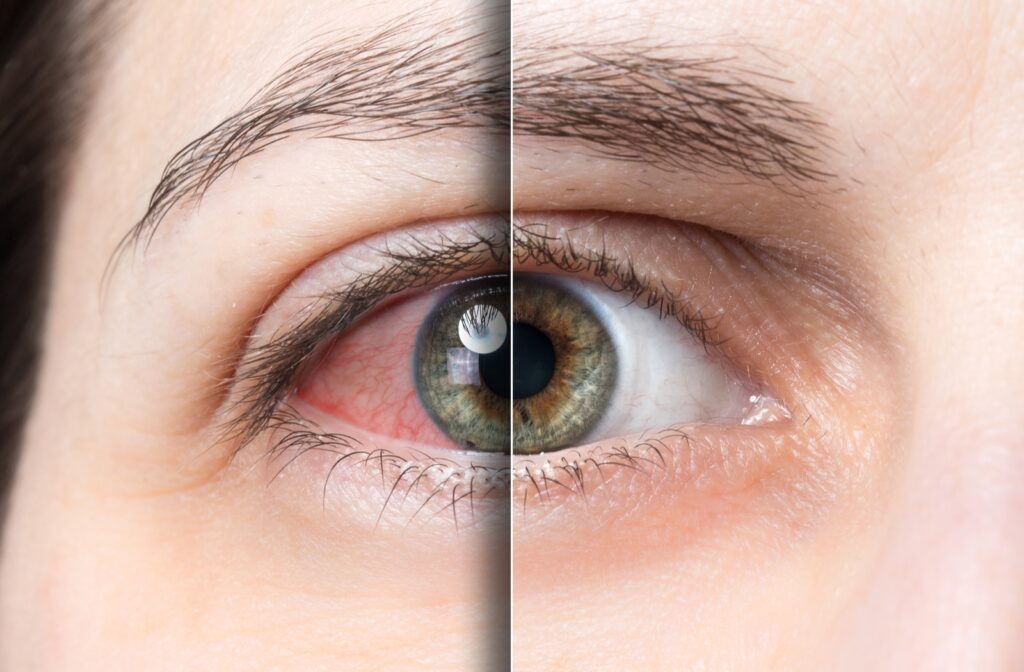Is Chronic Dry Eye Syndrome Able to Cause Floaters?
Your eyes are your window to the rest of the world and require consistent care. Keeping up with regular eye exams to monitor your visual health is essential and can help your optometrist remain familiar with your visual needs.
Dry eye syndrome and floaters are 2 vision conditions that can stress you out and cause discomfort. But are they related? Let’s look at if chronic dry eye syndrome can cause floaters to appear.
What Is Dry Eye Syndrome?
Dry eye syndrome is a common condition that occurs when your eyes do not produce enough tears to stay lubricated or something has gone wrong with the tear production process. A lack of tear production can lead to eye inflammation and damage to your cornea.
Some common signs and symptoms of dry eye can include:
- Eye pain
- Excessive tears
- Eye redness
- A scratchy feeling
- Burning sensation
The first step to finding relief is to book a comprehensive eye exam and get a thorough assessment to determine the cause of your dry eyes. Once your optometrist determines the cause of your dry eyes, they can begin offering treatment options.
Your tears are made up of 3 layers. These layers include the oily outer layer, the watery middle layer, and the inner mucus layer. Dry eyes can occur if the glands that produce these elements of your tears do not produce enough or become inflamed.
Some treatment options your optometrist can offer include:
- Lid therapy
- BlephEx
- Intense pulsed light (IPL)
- Omega-3 fatty acids
Your type of treatment will depend on the type of dry eyes you have:
- Aqueous tear deficiency (caused by low-quality tears)
- Evaporative dry eye (caused by a lack of tears)
Dry eye syndrome can cause discomfort, and if left untreated, dry eye can lead to more severe complications such as eye infections or damage to the eye’s surface.

What Are Floaters?
Floaters appear as tiny, semi-transparent cobwebs, specks, or squiggles that appear in your field of vision. Floaters are small particles within the gel inside your eye and become more noticeable as they drift into your line of sight.
Floaters move as your eyes move, so you’ll never be able to focus on them entirely. Floaters become more common as you age, and almost everyone sees floaters at some point.
The inner part of your eye is composed of a clear, jelly-like fluid known as the vitreous. The deterioration of this eye fluid causes floaters.
Most floaters are normal and rarely cause severe issues. However, if you notice a sudden increase in floaters, you should contact your optometrist as that can indicate problems such as a retinal hole or a tear or detachment.
Can Dry Eye Cause Floaters?
While dry eye syndrome and floaters share similar risk factors, a link has not been found between them. Dry eyes can happen due to poor tear quality or a lack of tear production, while floaters can happen as people age and the eye changes.
Along with the natural process of aging, eye conditions that can cause floaters include:
- Eye infections or injuries
- Eye inflammation
- Bleeding in the eye
- Retinal tear
- Retinal detachment
A sudden appearance of floaters can also signify something more severe.
Dry eyes and floaters are unrelated conditions that can develop with age. Different diagnosis and treatment options exist for both. If you see a sudden increase in floaters, it’s essential to contact your optometrist for a comprehensive eye examination as soon as possible.
Maintaining Healthy Vision
The appearance of dry eyes and floaters can be challenging to deal with. A comprehensive eye exam with your optometrist can help alleviate some concerns and get to the bottom of your eye health issues.
Book an appointment with your optometrist to learn more about dry eyes and floaters—get the treatment you need today!




